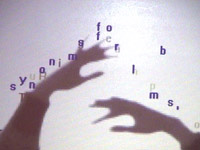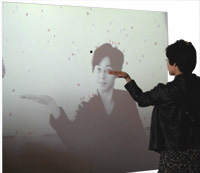[Status: Draft]
Related Categories: Text Visualization | Text and Multimedia | Art Installations | Immersive Text Environments
Summary:
Art installation of 1999 by Camille Utterback and Romy Achituv. To interact with the installation participants stand or move in front of a large projection screen. On the screen they see a mirrored video projection of themselves in black and white, combined with a color animation of falling text. Like rain or snow, the text appears to land on participants’ heads and arms. The text responds to the participants’ motions and can be caught, lifted, and then let fall again. The falling text will “land” on anything darker than a certain threshold, and “fall” whenever that obstacle is removed. If a participant accumulates enough letters along their outstretched arms, or along the silhouette of any dark object, they can sometimes catch an entire word, or even a phrase. The falling letters are not random, but lines of Evan Zimroth’s poem about bodies and language, “Talk, You.” As letters from one line of the poem fall towards the ground they begin to fade, and differently colored letters from the next line replace them from above. “Reading” the poem in the Text Rain installation becomes a physical as well as a cerebral, perhaps even an impossible, endeavor[1].
Description:
The Text Rain interactive installation developed out of AbacusParts–a series of theatre and dance collaborative workshops produced and directed by Romy Achituv and Danielle Wilde in New York City in 1997-98. An early idea for the piece was to create an interactive installation for the stage, which would display a handwritten classical manuscript about perspective, possibly by Brunelleschi or Durrer [sic]. The manuscript was to scroll into the screen from the top and slowly “disintegrate” into letters and diagram-parts, which would flow around the captured image of the performers. Evan Zimroth’s 1993 poem “Talk, You” was selected for Text Rain due to its resonance with the structure of the piece–for, as Utterback and Achituv stress, it creates metaphorical bridges between the physical and the linguistic; it employs images of the body moving through space to speak of interpersonal relationships, illustrating how “meanings” come together and fall apart through transient “syntactical” spatial relationships[2]. As the piece evolved, the focus shifted from developing a piece for use in performance, to a free-standing installation.
Interaction between the viewers/performers and the text creates a unique dynamic suited for both individual and collaborative exploration. Viewers work together to decipher the poem, communicating with each other through their projected/mediated image, or alternatively, disrupt the “reading” of the poem by stealing letters from one another. One’s image is inserted into a flat abstract space along with the text, while the text acts as objects that respond to forces in the real world and also to the physical gestures of viewers. Just as one’s body is “dematerialized” onto the projected screen, the text is “materialized,” appearing as substances that respond to physical movement. The text “continues to serve its symbolic function as an decipherable code, but also as an ‘object’ viewers can engage with as if it were a real physical entity […] the physical act of catching letters is necessary in order to read the text at all […] Because most of one’s body is visible in the virtual space of the screen as well as in the physical space in front of the screen, a pleasurable confusion results between the screen space and the real space”[3] .

The structure of the interaction is clear, predictable in how the words will fall and hold, if not what phrases they will form. It is readily apparent that holding out one’s hand or any other object will stop the letters from falling. Which letters will fall next, and whether one can catch enough letters to form legible words, however, is unpredictable[4]. The video-tracking interface design of Text Rain feels “transparent” for a number of reasons. Text Rain responds immediately to a person’s presence, whether or not that person intends to interact with the piece. There is no donning of complicated headgear, and no queuing up for your turn. Because the boundary between being “in” or “out” of this virtual space is only a matter of attention, users can talk and engage freely with other people in the installation space, while simultaneously playing with the letters in the virtual space. The boundary between the real space and the virtual space is “thin” because it is easy for users to be present in either the real or virtual space, to seamlessly shift between the two, or to feel present in both simultaneously. The interaction with this system also takes advantage of the fact that people already know how to manipulate their bodies–particularly in front of something that resembles a mirror. Participants are not asked to learn a new metaphor to operate the interface. If we want to catch something in the real world, we hold out our arms–which is exactly how the interaction works in Text Rain [5].

Evaluation of Opportunities/Limitations for the Transliteracies Topic:
Text Rain is a compelling installation because it remains entirely simple and intuitive, yet creates a provocative experiences at the intersection of the body and the symbolic. One is accustomed to interacting with their reflection or shadow, and the “falling” letters appear to be under the effect of gravity. The “familiar instrument” of the body becomes slightly defamiliarized as a two-dimensional contour that shares the same plane of the poem. While Utterback implies that “poetic” interfaces do not necessarily need to maintain control, the physically familiar and constrained interactions with the text here provide enough control to allow the “pleasurable confusion” between “screen space” and “real space” that the artists’ note. Matt Gorbet likens such works to the haiku–they have a certain grace and power in their rigid simplicity[6]. He wonders, however, what the appropriate interaction would be for progressing to a new body of text; how might one “turn the page” or choose a different “chapter”[7]? It seems that to do so would be to sacrifice the ease with which one enters and exits the installation. In such works, “turning the page” could mean either launching a new poem, or altering the mode of bodily interaction (the text could “float up,” for example). The “falling” letters reveal something of our interactions with electronic text as well as our bodily orientation in space. Scrolling an electronic document, words rise or fall, and we “catch” phrases by controlling the side bar. If the letters in Text Rain were to “blow in” from the side, they would simply brush up upon the vertically integrated body; while the visitor could “push” the words voluntarily, this lacks the playful challenge of “catching” and “holding” the letters as they fall, and the communal act of joining arms to construct a text about relationships stresses that poetry, at its best, unifies.
Resources for Further Study:
- Gorbet, Matt. Response to “Unusual Positions.” First Person: New Media as Story, Performance, and Game. Ed. Noah Wardrip-Fruin and Pat Harrigan. Cambridge: The MIT Press, 2004.
- Siggraph. “Text Rain.” Siggraph 2000 Art Gallery. Feb. 2001.
- Utterback, Camille. “Text Rain” Home Page.
- —-. “Unusual Positions–Embodied Interaction with Symbolic Spaces.” First Person: New Media as Story, Performance, and Game. Ed. Noah Wardrip-Fruin and Pat Harrigan. Cambridge: The MIT Press, 2004.
- —-. “Designing Systems for Human Interaction—Not Human-Computer Interaction.” Core 77. Nov 2002.
- —-. “Camille Utterback Responds in Turn.” electronic book review. 22 Mar 2004.
- Utterback, Camille and Romy Achituv. “Text Rain.” Text and Language. Special Issue of Aspect Magazine. Vol. 4
End Notes:
[1]See Siggraph.org, and Camille Utterback, “Unusual Positions–Embodied Interaction with Symbolic Spaces,” in First Person: New Media as Story, Performance, and Game, ed. Noah Wardrip-Fruin and Pat Harrigan (Cambridge: The MIT Press, 2004) 220-21.
[2]See the artists’ statement in Aspect Magazine.
[3]Utterback, “Unusual Positions,” 221.
[4]See Camille Utterback Responds In Turn in electronic book review.
[5]See “Designing Systems for Human Interaction, Not Human-Computer Interaction”.
[6]Response to “Unusual Positions,” in First Person, 222
[7]Ibid., 221.
